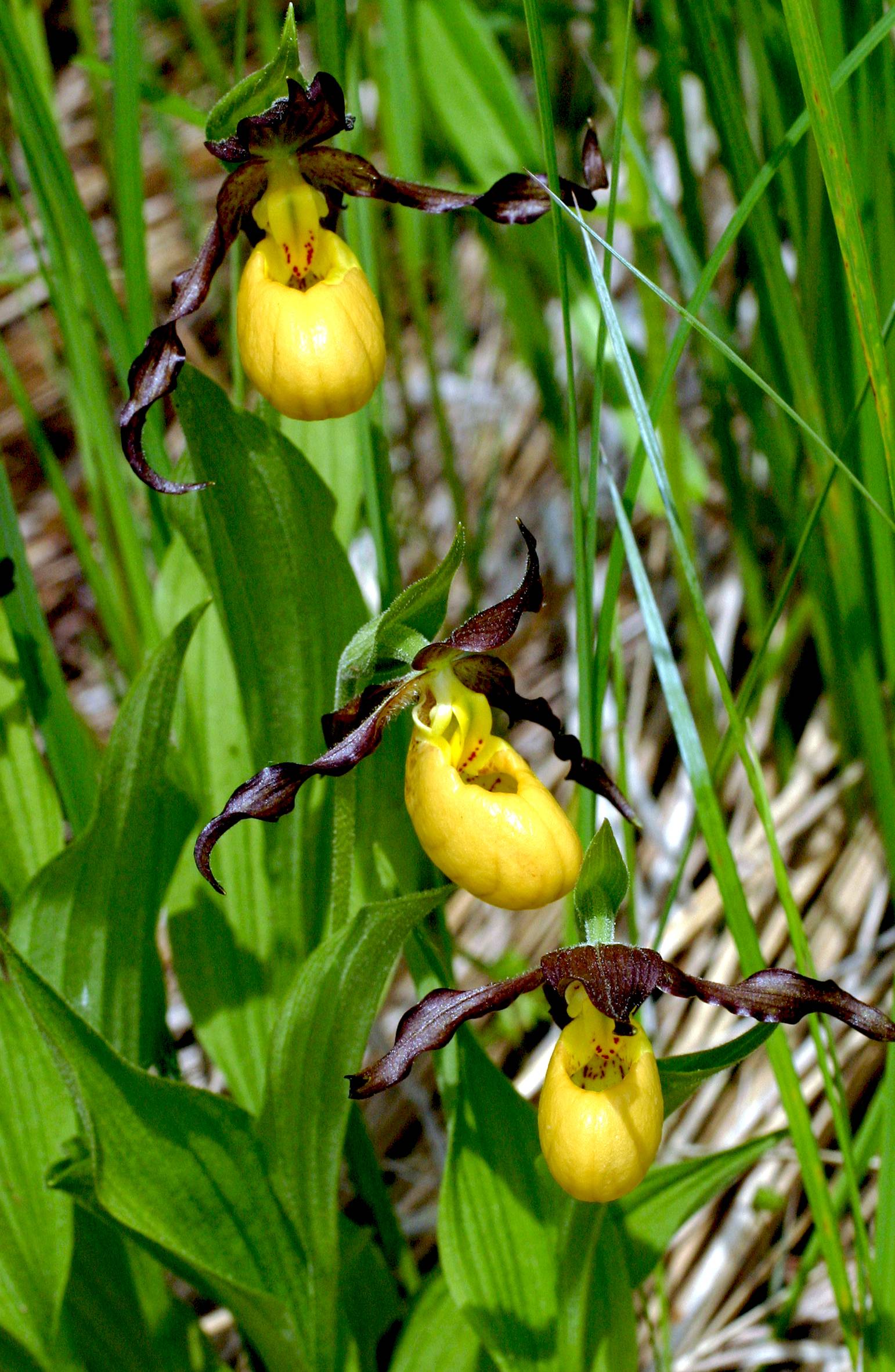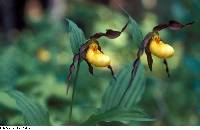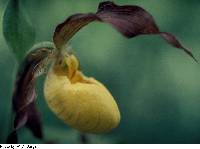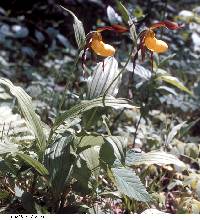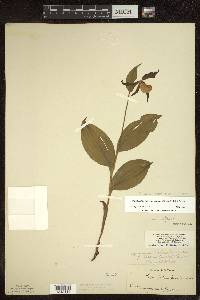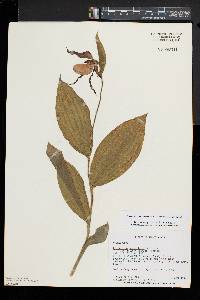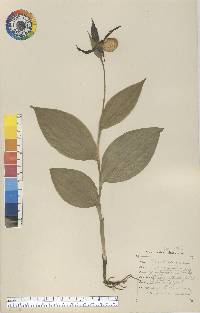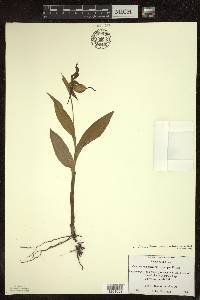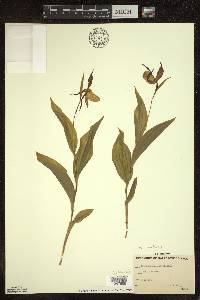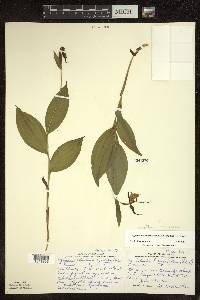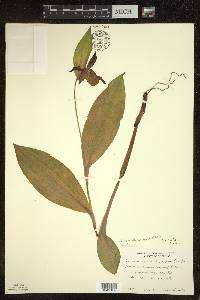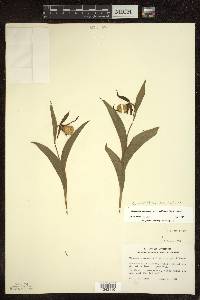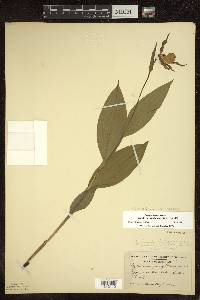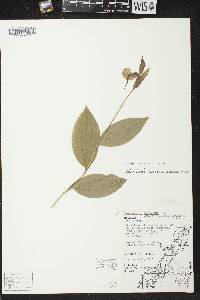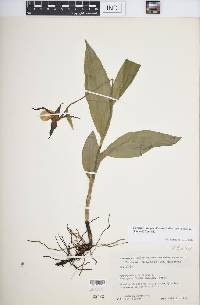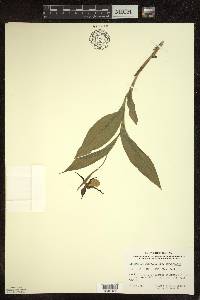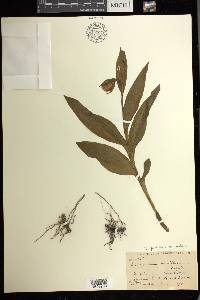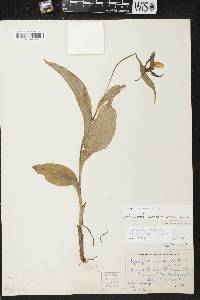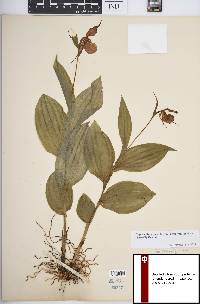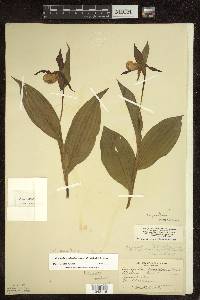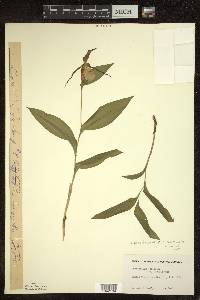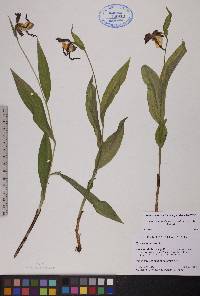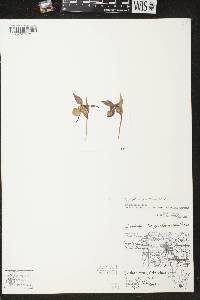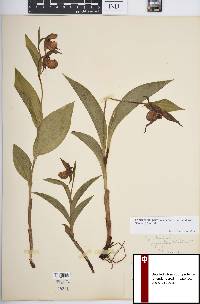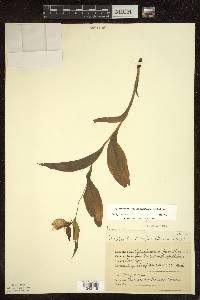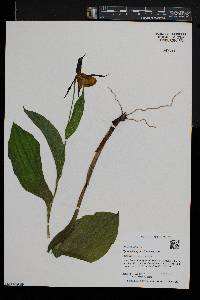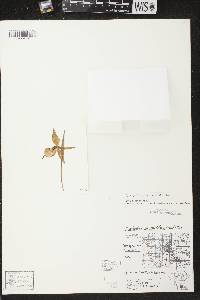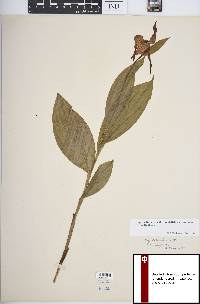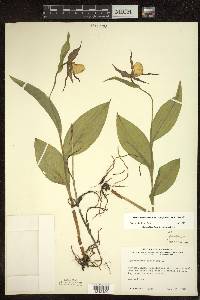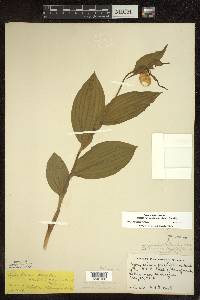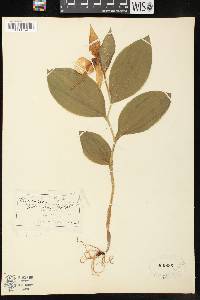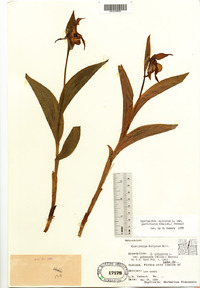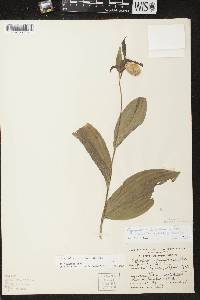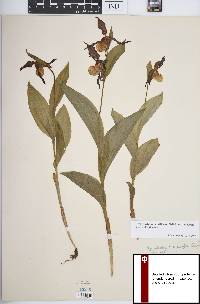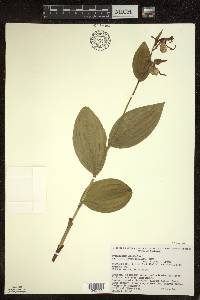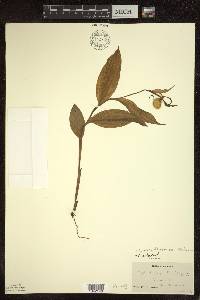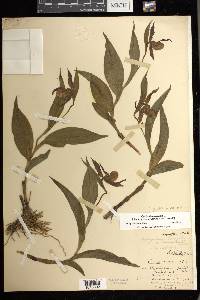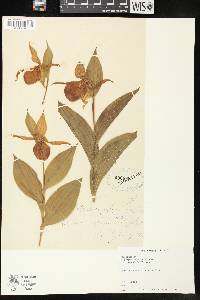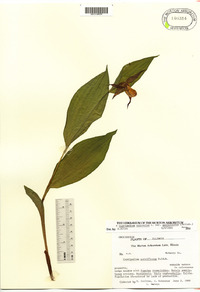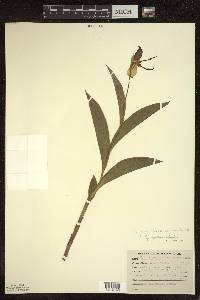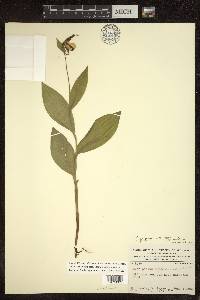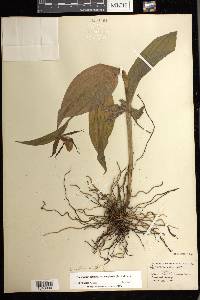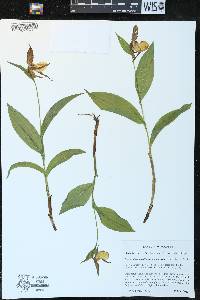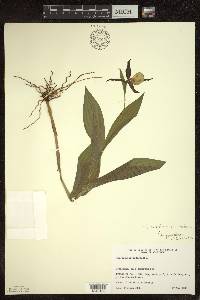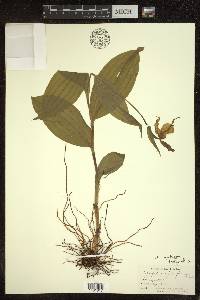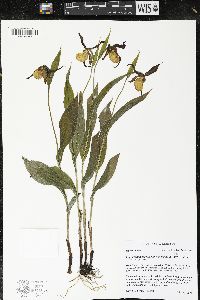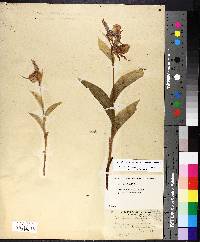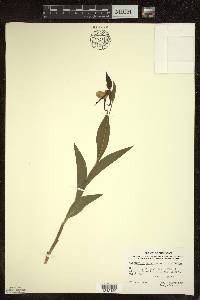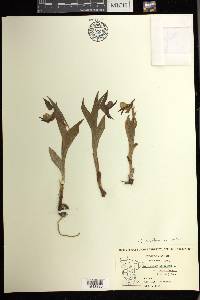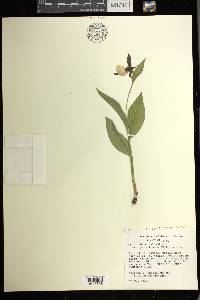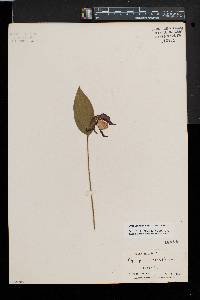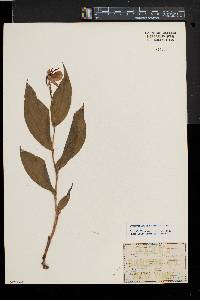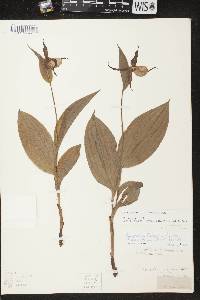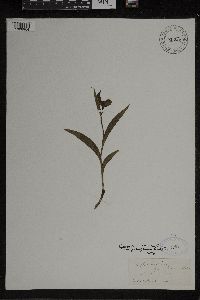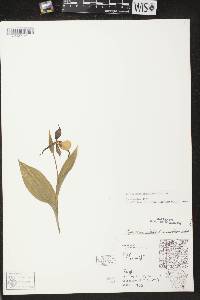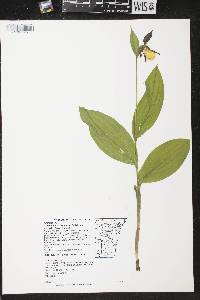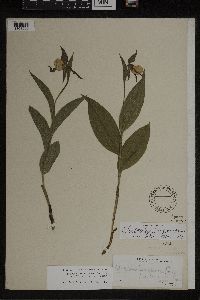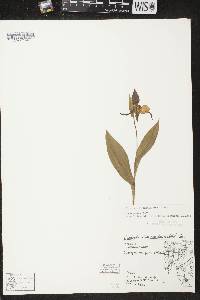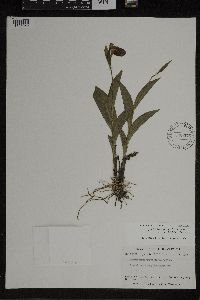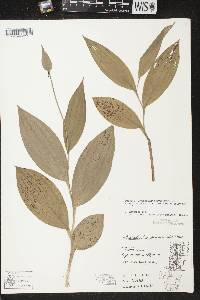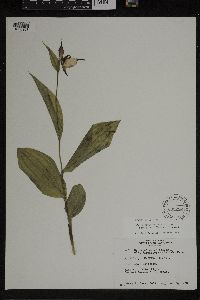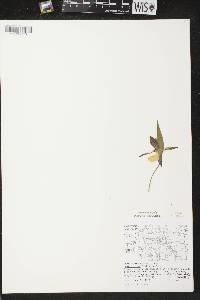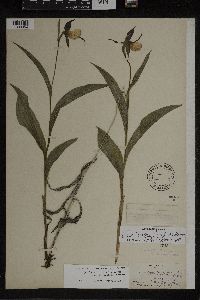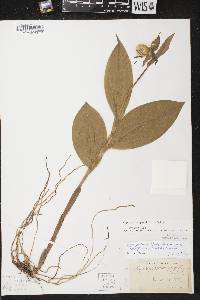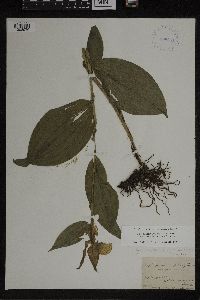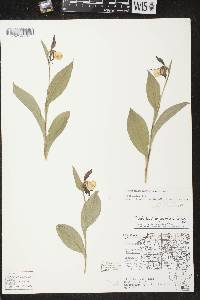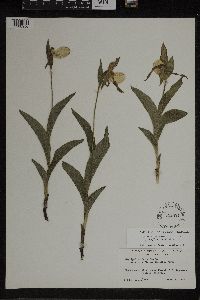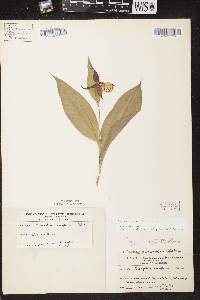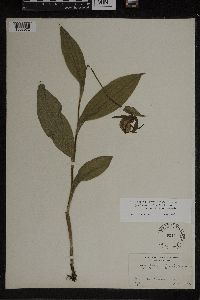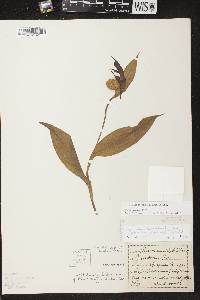Cypripedium parviflorum var. makasin
|
|
|
|
Family: Orchidaceae
Yellow Lady's-Slipper
[Cypripedium pubescens var. makasin Farw.] |
Bracts: abaxial surface of distalmost sheathing bract (and often the next) sparsely and inconspicuously pubescent or glabrous when young. Leaves (2-)3-5, on proximal portion of or more evenly spaced along stem, alternate, erect to spreading; blade orbiculate or broadly ovate to elliptic-lanceolate, 5.2-18.5 × 1.6-14.3 cm. Flowers 1-2(-3), small, scent intense, sweet; sepals and petals usually suffused with dark reddish brown or madder, or in west often spotted and blotched; lip oblance-ovoid to calceolate, 15-29 mm; orifice 10-17 mm. 2n = 20. Flowering May--Aug. Mesic to wet fens, prairies, meadows, thickets, open coniferous and mixed forest; mostly 0--1500 m; Alta., B.C., Man., N.B., Nfld. and Labr., N.W.T., Ont., P.E.I., Que., Sask., Yukon; Alaska, Calif., Conn., Ill., Ind., Iowa, Maine, Mass., Mich., Minn., Mont., N.J., N.Y., N.Dak., Ohio, Pa., Utah, Vt., Wash., Wis. Perennial herb 15 - 40 cm tall Stem: one, erect, green, leafy, small, dainty, and short-hairy. Though there is only one stem per plant, they tend to form large clumps, and therefore usually there are several stems per clump. Leaves: two to five, often clustered near base, alternate in two ranks, erect to spreading, stalkless, dark bluish green, 6 - 18.5 cm long, 1.6 - 14.3 cm wide, somewhat elliptic to rounded or broadly egg-shaped, non-toothed, folded lengthwise, strongly ribbed, and short-hairy. The leaves are especially noticeably folded at blooming time, though they tend to clasp less than in the other variety in our area. Inflorescence: of one or two (rarely three), erect, terminal, stalked flowers closely subtended by a stalkless, sheathing, erect, green, leaf-like, 5 - 6 cm long, 1.5 - 2 cm wide, often folded, narrowly egg-shaped to lance-shaped bract. The bract base sheaths the flower stalk, and the underside is usually hairless, though it may be inconspicuously short-hairy when very young. Flowers: showy though small, intensely sweet-scented (similar to vanilla), glossy soft yellow, short-hairy, bilaterally symmetric with relatively short (maximum 3 cm), highly modified, very inflated, widely egg-shaped lip petal held somewhat horizontal (tip usually higher than base). Unlike other orchids, the reproductive parts of stamens and stigma are not fused into a column above the inferior ovary, but instead at the basal opening of the lip petal there are two separate anthers, one large, sterile, modified staminode, and a lobed stigma above the short-hairy inferior ovary. Sepals: three, but two lower fused together (except notch at tip) into a deep maroon or dark red-brown, 3 - 3.5 cm long, about 1.5 cm wide, short-hairy, but polished and glossy synsepal positioned behind and below lip petal. The remaining sepal is similar in color, sheen, and hairiness, but is typically longer (up to 5 cm ), egg- to lance-shaped, and positioned uppermost extending forward above the inflated lip petal. Fruit: one or two, stalked, erect, ellipsoid, short-hairy capsules with remnant reproductive parts at tip, raised lengthwise angles, and stalk subtended only by basal sheath of bract. Root system: of slender, fleshy, fibrous, 7 - 12 cm long true roots arising from rhizomes. Lateral petals: two, horizontal to strongly descending, same color as sepals, short-hairy, polished, glossy, 3 - 5 cm long, about 0.5 cm wide, tightly spirally twisted, narrowly linear to lance-shaped, widest at base, and tapering to pointed tips. Lip petal: one, central, lowermost, soft yellow, glossy, 1.5 - 3 cm long, about 1.5 cm wide, greatly inflated, pouch-like, widely to inversely egg-shaped, and short-hairy. On the inner surface of the pouch the veins are colored dark purple, which appears faintly purple greenish on the outside (especially along the bottom), and there are commonly purple spots surrounding and inside the basal opening (orifice) of the petal. Basal orifice 1 - 1.7 cm long, with outer edge (opposite staminode) forming blunt obtuse angle. Staminode: one, prominent, yellow with purple markings, triangular, and positioned below upper sepal and pointing down to basal opening (orifice) of lip. On the back side of the staminode the two anthers are positioned on each side of the central lobed stigma. Similar species: Cypripedium parviflorum var. makasin is most similar to the other variety in our area, C. parviflorum var. pubescens, but that variety differs by having more strongly clasping leaves, the under surface of the sheathing bract is densely and obviously covered with silver hairs when young (later sometimes more hairless), flowers are larger (lip 2 - 5.4 cm long), sepals and lateral petals are unmarked or inconspicuously spotted or striped with reddish brown (rarely extensively blotched and never uniformly dark), and the floral scent is faint and musty to rose-like. The hybrid C. x andrewsii is also very similar, but it never has glossy yellow lip petals, rather the lip is typically dull off-white (either ivory-white, or pale cream then fading to dull yellowish), and some hybrids may have sepals and lateral petals that are greenish yellow and only streaked with brown. Flowering: mid-May to June Habitat and ecology: Uncommon, a wetland plant often in seepage areas with calcareous muck, or saturated peat with cool slow moving ground water, and typically in light shade. Its habitats are similar to those of C. reginae, which can include open calcareous swales, calcareous sloping marshy areas, fens, and mesic sand prairies. Occurence in the Chicago region: native Notes: This lady's slipper is probably the most common species in which to see populations with two flowers per stem. This variety is the one more commonly hybridizing with C. candidum to produce C. x andrewsii in our area. The habitat preferences of C. parviflorum var. makasin overlap with those of C. candidum as well as C. reginae. Despite the relatively small flowers of this lady's slipper, it is a striking species with the dark sepals and lateral petals surrounding the contrasting glossy yellow pouch lip petal. The pouch of the flower in this variety is held quite horizontal to the ground or even slightly raised at the tip unlike the more drooping lip of the other variety, C. parviflorum var. pubescens. Many published floras still call this plant C. calceolus var. parviflorum, but we follow the recent Flora of North America treatment (Sheviak 2002). Etymology: Cypripedium comes from combining the Greek word Kypris for Cypris (Aphrodite), the goddess of love and beauty; and either the Latin word pedis meaning foot, or possibly an orthrographic error for the Greek word pedilon meaning sandal or slipper; together translating roughly to beauty's or lady's foot or slipper, in reference to the inflated lip petal resembling a woman's slipper or shoe. Parviflorum means small flower, which refers to the relative small size of the flowers. Makasin derives from the word moccasin, which refers to the shape of the lip resembling the Native American shoe. Author: The Field Museum From Flora of Indiana (1940) by Charles C. Deam Since Indiana has been so completely drained the typical form of this species has become very rare. It is generally found in boggy places and in the dunes on the wet borders of sloughs. It is rarely found in woodland. |

